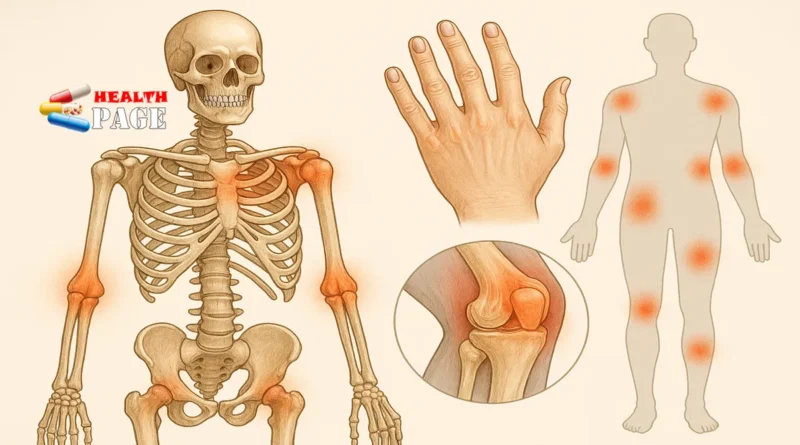What is arthralgia and Causes of occurrence
Arthralgia is a symptom of joint pain, characteristic of one or several joints at the same time (polyarthralgia). It is caused by irritation of neuroreceptors of the synovial membranes of the joint capsules by inflammatory mediators, products of immune reactions, salt crystals, toxins, osteophytes, etc. Arthralgia can be observed in rheumatic, endocrine, infectious, tumor, neurological, autoimmune diseases, injuries, excess weight. Determining the causes of arthralgia has important differential diagnostic significance. Treatment of arthralgia is reduced to therapy of the disease that caused it; symptomatic measures are used – analgesics, local heat and ointments.
Joint diseases.
It is noteworthy that this syndrome is characterized by the absence of an objective symptom complex, which is typical for other joint diseases. In particular, with arthralgia, there are no deformations, localized increase in temperature, redness and pain during palpation. In addition, there are no significant limitations in mobility and often no radiographic signs detected in inflammatory diseases of the joints. At the same time, it should be remembered that arthralgia can be a harbinger of serious damage to the joints (or some extra-articular diseases). Therefore, at the first signs of arthralgia, it is necessary to consult a doctor and undergo a full diagnosis, which may indicate a disease accompanied by arthralgia.
It is worth noting that arthralgias are different. Thus, the manifestation of this syndrome varies in localization and intensity of pain. In addition, arthralgia varies in the number of joints involved, the duration of the painful period, daily rhythm, and also the connection with certain types of movements.
Arthralgia pain
If with arthralgia pain is noted only in one joint, then in this case they speak of monoarthralgia. If pain is in several joints at once, then this is polyarthralgia. In this case, pain in 5 or more joints indicates polyarthralgia syndrome.
As for the nature of arthralgic syndrome, acute and dull pain are distinguished. According to the intensity of pain sensations, arthralgia can be weak, moderate and intense. Depending on the periodicity of symptoms, arthralgia can be transient and constant.
Most often, arthralgia occurs in large joints, such as the hip, knee, shoulder, and elbow. In rare cases, arthralgia affects small joints, such as the wrist, ankle, interphalangeal, and others.
The following types of joint pain are distinguished:
- Arthralgia occurring during acute infectious processes.
- Arthralgia caused by acute or recurrent arthritis.
- Long-term monoarthralgia of large joints.
- Oligo- or polyarthralgia syndrome. In this case, the synovial membranes are involved in the pathological process. In addition, degenerative-dystrophic changes in the cartilage are possible.
- Post-traumatic arthralgia.
- Pseudoarthralgia.
Causes of occurrence
As a rule, arthralgia is caused by osteoarthritis (chronic mono- or polyarthritis) or viral polyarthritis (acute polyarthritis).
Osteoarthritis is an extremely common disease. It can be primary and secondary. Primary osteoarthritis is characterized by symmetrical damage to several joints. Secondary osteoarthritis occurs more often after an injury, so joint damage is usually asymmetrical.
Viral polyarthritis is very common (much more common than most doctors assume). The causative agents are influenza viruses, mumps, rubella, chickenpox, hepatitis A and B, Ross River fever, Epstein-Barr virus, cytomegalovirus, parvoviruses. Symmetrical joints are affected, usually of the hands and feet, arthritis symptoms are moderate, changes are completely reversible. Viral polyarthritis ends with rapid spontaneous recovery.
Purulent infection
Arthralgia and arthritis may be caused by purulent infection (gonococcal, staphylococcal, streptococcal), rheumatoid arthritis (in 25% of cases it begins with monoarthritis), tuberculosis, infective endocarditis and rheumatism.
Rheumatic attack is characterized by migratory polyarthritis with predominant damage to large joints. The joints are sharply painful upon palpation and movement, the skin above them is red, hot to the touch, periarticular tissues are edematous. Symptoms persist for several days (on average – 5 days). Migratory polyarthritis is also observed in infective endocarditis. This disease is characterized by fever, weakness, heart murmurs.
Rash and migrating arthralgia, as well as purulent mono- or oligoarthritis, may be manifestations of disseminated gonococcal infection. Arthritis and sacroiliitis are characteristic of brucellosis and spondyloarthropathies. Due to the influx of immigrants from Southeast Asia, tuberculosis of bones and joints is increasingly common.
Other causes of arthralgia include HIV infection, collagenoses and neoplasms.
In HIV infection, subacute oligoarthritis with asymmetric joint damage and a rash that sometimes resembles psoriatic rash are observed. Arthralgia and arthritis are very often observed in collagenoses (systemic lupus erythematosus, systemic scleroderma, dermatomyositis).
Arthralgia in malignant neoplasms can be both paraneoplastic and caused by bone metastases. Paraneoplastic arthralgia is observed in acute leukemia, lymphomas, neuroblastomas. Lung cancer causes hypertrophic osteoarthropathy, which is characterized by symmetrical deformation of the long tubular bones (especially in the ankle and wrist joints) and fingers (in the form of drumsticks), arthralgia, and less often oligo- and polyarthritis. Metastases to joints (usually to the knee) are observed in lung and breast cancer.

